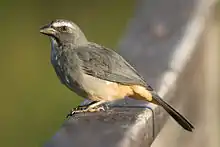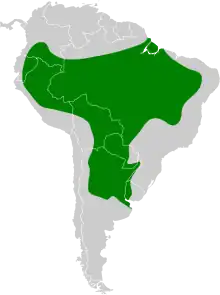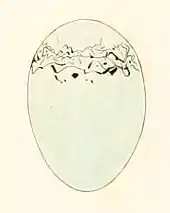| Bluish-grey saltator | |
|---|---|
 | |
| In the Pantanal, Brazil | |
| Scientific classification | |
| Domain: | Eukaryota |
| Kingdom: | Animalia |
| Phylum: | Chordata |
| Class: | Aves |
| Order: | Passeriformes |
| Family: | Thraupidae |
| Genus: | Saltator |
| Species: | S. coerulescens |
| Binomial name | |
| Saltator coerulescens Vieillot, 1817 | |
 | |
| Range in green | |
The bluish-grey saltator or Amazonian grey saltator (Saltator coerulescens) is a passerine bird in the tanager family Thraupidae that is widespread in semi-open habitats in tropical and subtropical South America.
Two of its former subspecies groups, grandis (of Mexico and Central America) and olivascens (of northern South America and Trinidad), are now recognized as separate species, the cinnamon-bellied saltator and the olive-grey (or Caribbean grey) saltator.[2]
Taxonomy
The bluish-grey saltator was formally described in 1817 by the French ornithologist Louis Pierre Vieillot under the binomial name Saltator coerulescens.[3] Vieillot based his description on the "Habia de la Ceja Blanca" that Félix de Azara had described in 1802 in his book on birds in Paraguay and the Río de la Plata.[4][5] The specific epithet coerulescens is derived from Latin and means "bluish".[6]
Saltator coerulescens was formerly known as the greyish saltator and included two subspecies groups: grandis (including brevicaudus, hesperis, plumbiceps, vigorsii and yucatanensis) and olivascens (including brewsteri and plumbeus). In 2021, they were recognized as separate species, the cinnamon-bellied saltator (S. grandis) and olive-grey (or Caribbean grey) saltator (S. olivascens).[2] With these as separate species, S. coerulescens includes the subspecies azarae, mutus and superciliaris.
Description
On average, the bluish-grey saltator is 20 cm long and weighs 52 g. The plumage depends on age and subspecies, but in general this bird has grey or greyish-olive upperparts, a white stripe over the eye, a narrow white throat, a grey breast and a buff or cinnamon belly.
The common call is a long-drawn upward slur, ch'wheeet or ch'kweeee, sometimes with a more elaborate beginning, as hi'whee chu weeeeh. The song is a warble, usually fairly short, varying from nasal to mellow.[7]
Distribution and habitat
This species occurs in a wide range of semi-open habitats, such as woodlands, scrub and edges of forest (it avoids the interior of dense forests) in tropical and subtropical South America, including northern Argentina, western Uruguay, Paraguay, widely in Brazil (being replaced by the olive-grey saltator in the extreme north near the borders with the Guianas and Venezuela), Bolivia, eastern Peru, eastern Ecuador, and southeastern Colombia (being replaced by the olive-grey saltator in central and northern parts of the country).
Behaviour and ecology
The bluish-grey saltator feeds on fruits,[8] buds and slow-moving arthropods. It forages at low and middle levels, sometimes in pairs or small groups and sometimes with mixed-species flocks that may include other saltators.[7]

The two pale blue subelliptic eggs per clutch measure some 23–31.5 mm long by about 17–22 mm wide and weigh about 5 grams each. They look unusual for this genus as they have a circle of blackish-brown hairstreaks and dots around the blunt end.[9] They are laid in a bulky cup nest 2–4 m high in a tree.
References
- ↑ BirdLife International (2017). "Saltator coerulescens". IUCN Red List of Threatened Species. 2017: e.T103812647A119478431. doi:10.2305/IUCN.UK.2017-3.RLTS.T103812647A119478431.en. Retrieved 12 November 2021.
- 1 2 "Species Updates – IOC World Bird List". Retrieved 2021-06-13.
- ↑ Vieillot, Louis Pierre (1817). Nouveau dictionnaire d'histoire naturelle, appliquée aux arts, à l'agriculture, à l'économie rurale et domestique, à la médecine, etc (in French). Vol. 17. Paris: Deterville. pp. 105–106.
- ↑ Azara, Félix de (1802). Apuntamientos para la historia natural de los páxaros del Paragüay y Rio de la Plata (in Spanish). Vol. 1. Madrid: Imprenta de la Hija de Ibarra. pp. 344–348, No. 81.
- ↑ Paynter, Raymond A. Jr, ed. (1970). Check-List of Birds of the World. Vol. 13. Cambridge, Massachusetts: Museum of Comparative Zoology. pp. 232–233.
- ↑ Jobling, James A. (2010). The Helm Dictionary of Scientific Bird Names. London: Christopher Helm. p. 113. ISBN 978-1-4081-2501-4.
- 1 2 Howell & Webb (1995)
- ↑ E.g. of Trophis racemosa (Moraceae): Forster (2007).
- ↑ Echeverry-Galvis & Córdoba-Córdoba (2006)
Further reading
- Bencke, Glayson Ariel (2007): Avifauna atual do Rio Grande do Sul, Brasil: aspectos biogeográficos e distribucionais ["The Recent avifauna of Rio Grande do Sul: Biogeographical and distributional aspects"]. Talk held on 2007-JUN-22 at Quaternário do RS: integrando conhecimento, Canoas, Rio Grande do Sul, Brazil. PDF abstract
- Echeverry-Galvis, María Ángela & Córdoba-Córdoba, Sergio (2006): Descripción del huevo del saltátor collarejo (Saltator cinctus) y comentarios preliminares sobre huevos del género Saltator. ["Description of the egg of the Masked Saltator (S. cinctus) and preliminary comments on the eggs of the genus Saltator"]. Boletín de la Sociedad Antioqueña de Ornitología 16(1): 76–84. [Spanish with English abstract] PDF fulltext
- ffrench, Richard; O'Neill, John Patton & Eckelberry, Don R. (1991): A guide to the birds of Trinidad and Tobago (2nd edition). Comstock Publishing, Ithaca, N.Y.. ISBN 0-8014-9792-2
- Foster, Mercedes S. (2007): The potential of fruiting trees to enhance converted habitats for migrating birds in southern Mexico. Bird Conservation International 17(1): 45–61. doi:10.1017/S0959270906000554 PDF fulltext
- Hilty, Steven L. (2003): Birds of Venezuela. Christopher Helm, London. ISBN 0-7136-6418-5
- Howell, Steven N. G. & Webb, Sophie (1995): A Guide to the Birds of Mexico and Northern Central America. Oxford University Press, Oxford & New York. ISBN 0-19-854012-4
- Stiles, F. Gary & Skutch, Alexander Frank (1989): A guide to the birds of Costa Rica. Comistock, Ithaca. ISBN 0-8014-9600-4
External links
- Photograph from the Salvadoran Ministry of the Environment and Natural Resources
- Bird song display list with .wav file of call
- Grayish Saltator videos, photos & sounds on the Internet Bird Collection
- "Grayish Saltator" photo gallery VIREO Photo-High Res--(Close-up)
- "Grayish Saltator" photos from Suriname
